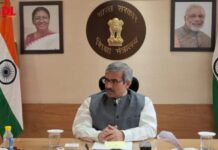There has been a complete change in the ambit of education, especially when it is discussed in the context of Indian states. Access to progress in education is but a few more clicks away right here in this part of India-Uttaranchal. Namrata Kumar, State Project Director of India’s flagship education for all project- Sarva Shiksha Abhiyan in a conversation with Sanjeev Kumar Shrivastav of Digital Learning, on the state’s educational roadmap that takes it to its own zeniths.
 The government of India provides the guidelines for all the states but unless the state having its own vision I do not think that they can be outstanding. If you really want to do something outstanding then you really need to have your vision. I take The government of India provides the guidelines for all the states but unless the state having its own vision I do not think that they can be outstanding. If you really want to do something outstanding then you really need to have your vision. I take proud in saying that every body from top to bottom is well informed about elementary education and providing all kind of support from whichever source is possible.
The government of India provides the guidelines for all the states but unless the state having its own vision I do not think that they can be outstanding. If you really want to do something outstanding then you really need to have your vision. I take The government of India provides the guidelines for all the states but unless the state having its own vision I do not think that they can be outstanding. If you really want to do something outstanding then you really need to have your vision. I take proud in saying that every body from top to bottom is well informed about elementary education and providing all kind of support from whichever source is possible.
What are the major interventions made under the Sarva Shiksha Abhiyan (SSA) programme in Uttaranchal so far?
We are implementing computer added learning programme in partnership with Azim Premji Foundation and it has worked out very well. We are doing it with upper primary school level where CD based content is being provided to students. Now the most positive effect of this programme that has happened that we are not going to just use the content or CD based content in teaching process in the class room and the additional part like how to operate the computer, what are the issues related to hardware and even ensuring electricity supply and electricity backup, all these important issues are also not bothering anymore.
Apart from that if you are asking use of technology in education programme, then we have made very novel initiative in this in a way using video conferencing to disseminate our instructions which is not just happening at the district level but also at block and village level. We conduct monthly meetings via video conferencing for VRC’s and CRC’s and also do meetings at the village level.
How much support do you get from Panchyati Raj institutions in your state while implementing your programmes?
One cannot rule out the role of Panchyati raj Institutons here, SSA has this as a base line factor. We have village education committee (VEC). At present these VECs which we created under SSA with the Panchyati Raj institutions will be the sub committees of the education committee. Every Panchyat has education committee and these VECs will be the sub-committees of these committees.
Do the state of Uttaranchal need any state specific vision or the guideline given by the centre is adequate enough?
The government of India provides the guidelines for all the states but unless the state having its own vision I do not think that they can be outstanding. If you really want to do something outstanding then you really need to have your vision. I take The government of India provides the guidelines for all the states but unless the state having its own vision I do not think that they can be outstanding. If you really want to do something outstanding then you really need to have your vision. I take proud in saying that every body from top to bottom is well informed about elementary education and providing all kind of support from whichever source is possible. proud in saying that every body from top to bottom is well informed about elementary education and providing all kind of support from whichever source is possible. What I mean is that our education minister, chief secretary, education secretary and every body is into it. The state wants to be performing above the guidelines stated in SSA and Government of India gives it.
Computer literacy of the students studying in high school and senior secondary levels (class VI to XII) as well as using computer technology for classroom teaching, is being addressed in an ambitious project named “Aarohi”. It has a simple mission statement, ‘Computer Literacy for All’. The Students who pass out of the government schools as well as the aided institutions shall be computer literate, irrespective of the fact of the economic situation and affordability. The pass percentage has risen from 45% to 64% for the intermediate and from 35% to 50% at the high-school level.
The training of teachers in the schools as Master Trainers (MTs) as well as Master Trained Professional Teachers (MTPTs), is being carried out in collaboration with Intel. The course curriculum, examination system and instructors have been provided by Intel






 The government of India provides the guidelines for all the states but unless the state having its own vision I do not think that they can be outstanding. If you really want to do something outstanding then you really need to have your vision. I take The government of India provides the guidelines for all the states but unless the state having its own vision I do not think that they can be outstanding. If you really want to do something outstanding then you really need to have your vision. I take proud in saying that every body from top to bottom is well informed about elementary education and providing all kind of support from whichever source is possible.
The government of India provides the guidelines for all the states but unless the state having its own vision I do not think that they can be outstanding. If you really want to do something outstanding then you really need to have your vision. I take The government of India provides the guidelines for all the states but unless the state having its own vision I do not think that they can be outstanding. If you really want to do something outstanding then you really need to have your vision. I take proud in saying that every body from top to bottom is well informed about elementary education and providing all kind of support from whichever source is possible.









